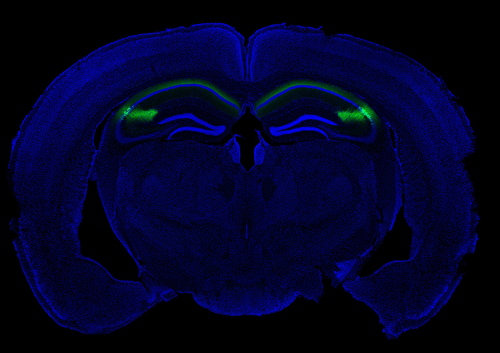Archived Content
The National Institute of Mental Health archives materials that are over 4 years old and no longer being updated. The content on this page is provided for historical reference purposes only and may not reflect current knowledge or information.
Brain Region Singled Out for Social Memory, Possible Therapeutic Target for Select Brain Disorders
• Science Update

A small region in the memory hub known as the hippocampus called CA2 (highlighted in green in this mouse brain section) is essential for social memory, the ability of an animal to recognize others of its kind. Knowledge of this region could lead to future treatments in brain disorders such as schizophrenia, bipolar disorder, and autism. Source: Stephen Siegelbaum, Ph.D., Columbia University Medical Center
Source: Stephen Siegelbaum, Ph.D., Columbia University Medical Center
Background
The hippocampus is essential for learning and memory—specifically the storage of knowledge of who, what, where, and when. Clues about the hippocampus’s roles emerged from the famous case of patient HM (Henry Molaison), who had most of his hippocampus removed by surgeons in 1953 to cure his epilepsy. HM became unable to form new memories of people he subsequently worked with for years.
Most previous studies of how memory is harnessed have focused on the trisynaptic pathway. In this neural circuit, information that is obtained from the entorhinal cortex—the main interface between the hippocampus and the neocortex or the outermostpart of the brain involved in higher functions such as thought or action—proceeds to the dentate gyrus, the front gate of the hippocampus. Granule neurons from the dentate gyrus then shuttle the information to interneurons and pyramidal cells of the CA3 region of the hippocampus, which then sends the information to the CA1 region, the main source of hippocampal output. Absent from this circuit is the CA2 subfield.
“Although the CA2 subregion was discovered over 75 years ago, it has received very little attention,” said Steven A. Siegelbaum, Ph.D., lead author of the study.
He ascribes two reasons for the inattention: size and location. CA2 has 10 percent the number of neurons of CA1 or CA3, raising questions about its importance. The region is also squeezed between CA1 and CA3, making it difficult to study with traditional approaches of physical or chemical lesions, which lack the precision to selectively target CA2.
To circumvent these problems, Siegelbaum, a neuroscience professor at Columbia University and a Howard Hughes Medical Institute Investigator, and Frederick L. Hitti, an M.D.-Ph.D. student, generated a special transgenic mouse in which the CA2 neurons could be selectively inhibited in adult animals. Once these neurons were inactivated, the mice underwent a series of behavioral tests.
Results of the Study
Normally when a mouse encounters another mouse it does not know, it gives it a “sniff test” and is more interested in this new mouse versus a familiar acquaintance. The CA2-inactive mouse, however, shows no recognition of mice it has seen before and ends up sniffing indiscriminately familiar and novel mice. The mice showed no loss in the ability to discriminate social or non-social odors, such as food buried deeply in its litterbox. Although a pronounced loss of social memory is seen in the CA2-inactive mice, the mice did not experience changes in other hippocampal-specific behaviors such as spatial and contextual memory, and could still distinguish between novel and familiar inanimate objects.
Significance
“Because several neuropsychiatric disorders are associated with altered social behaviors, our findings raise the possibility that CA2 dysfunction may contribute to these behavioral changes,” said Siegelbaum.
Individuals with schizophrenia and bipolar disorder have lowered numbers of CA2 inhibitory neurons. Similarly, individuals with autism have altered signaling of vasopressin, a social behavior hormone that interacts with a specific class of receptors found predominantly in this region. However, the CA2-inactive mice did not display classic symptoms of autism as they had normal levels of sociability, providing evidence that sociability and social memory involve different brain functions. Techniques such as the one detailed here are examples of research tools that the NIH Brain Research through Advancing Innovative Neurotechnologies (BRAIN ) Initiative hopes to build upon to further our understanding of the human brain.
What’s Next
Siegelbaum’s group hopes to use the same genetic technology to examine whether there are changes in CA2 function in mouse models of psychiatric disorders such as autism and schizophrenia. If so, they plan to screen for drugs that restore normal CA2 function and ask whether this drug treatment helps reverse any behavioral changes seen in the mice. Such research offers the possibility of finding new drug targets and approaches for treating the behavioral changes associated with these disorders.
Reference
Hitti FL, Siegelbaum SA. The Hippocampal CA2 Region is Essential for Social Memory. Nature , published online February 23, 2014.
